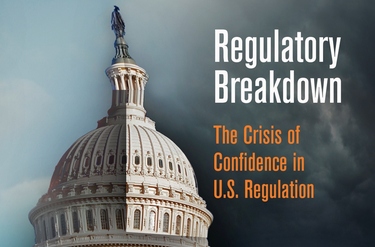
The Regulatory Review summarizes the work of leading scholars from the newly published book Regulatory Breakdown: The Crisis of Confidence in U.S. Regulation.
Events of the last several years have deeply shaken public confidence in the U.S. regulatory system. According to many observers, the financial crisis and the Gulf Coast oil spill would never have occurred but for lax regulatory oversight. Still others charge that the sluggish pace of the U.S. economic recovery stems in part from regulatory excesses, including the looming and uncertain new controls called for by the Dodd-Frank Act and the Affordable Care Act.
The modern United States regulatory system that emerged from the New Deal has never faced such a profound crisis of confidence. Public trust in government has declined and the political process has only grown increasingly polarized. Although we can expect more wrangling in Washington over fiscal matters in the months ahead, important and equally contentious debates over regulatory policy also seem likely to persist throughout President Obama’s second term.
In today’s heated political climate, academic research promises some much needed light. If policymakers do truly seek to fix what has gone wrong with regulation in the United States, they will need to rely on more than their ideological dispositions. To effectuate the best solutions, what policymakers and the public need is clear analysis of the causes of our current crisis, a careful assessment of possible policy alternatives, and empirical evaluations that discern the true impact that regulatory changes make on the world.
The chapters in Regulatory Breakdown: The Crisis of Confidence in U.S. Regulation speak to today’s need for clarity over regulatory policy and its reform. They also offer timeless lessons drawn from the experiences of the last several years. Edited by Penn Law Professor Cary Coglianese and written by some of the nation’s leading experts in law, economics, political science, and public policy, the book’s chapters collectively probe far beneath the surface-level diagnoses and debates that have characterized contemporary discourse.
In this series, The Regulatory Review features essays summarizing each of the chapters in Regulatory Breakdown. Each essay is written by a Penn Law student about a chapter from the book. We aim for our series, like the book itself, to help illuminate the contemporary regulatory predicament and advance the cause of bringing greater analytical and empirical attention to what truly ails the U.S. regulatory regime.
Assessing Regulations in the Wake of Disaster
“Carrigan and Coglianese posit that after a national disaster, critics and lawmakers typically choose regulation as their first object of blame. . . . Reforming regulation in the wake of disaster may feel like the necessary thing to do, but, as Carrigan and Coglianese demonstrate, it is not always needed or prudent.”
A Portfolio Approach to Addressing Catastrophic Risk
Improving the Regulation of Offshore Oil Drills
Maxwell Blum
How Should the U.S. Regulate Housing Finance After the 2008 Crisis?
Aimee Martin
Improving Crisis-driven Financial Regulation
Media, Polarization, and Regulatory Politics
Study Suggests that Public Attitudes Hinder Efficient Regulation
“Baron and his co-authors suggest that public misunderstanding of economic arguments for and against a variety of regulatory schemes prevents legislators from adopting the most efficient regulations. Ultimately, the authors identified two primary causes of the incongruity between efficient regulation and public preferences—citizens’ lack of understanding of economic efficiency and ideological views.”
Is the Rulemaking Process Really a Quagmire?
The Benefits of Public Advisory Committees at the FDA
Empowering the SEC to Stop Corporate Fraud
“According to Bratton and Wachter, ‘fraud on the market’ … neither deters individuals from fraudulent behavior nor adequately compensates victims for their loss. As a solution, Bratton and Wachter propose a two-pronged overhaul of both the “fraud on the market” doctrine and [shift of anti-fraud enforcement to the SEC].”
Is Class Action Litigation a Response to Regulatory Capture?
A Prescription for the FDA
“Ruger explains that unless the FDA adapts and becomes more flexible and responsive to the most pressing public health concerns, America’s policy solutions to food and drug issues will eventually rest in the hands of other regulators, including state, local, and other federal agencies, as well as private entities.”



